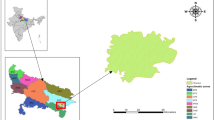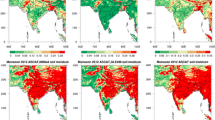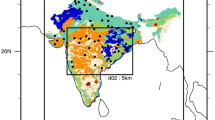Abstract
In this study, the decision support system for agrometeorology transfer (DSSAT) v4.6 model has been used to simulate soil moisture and evapotranspiration over central India (Madhya Pradesh) for the period 1990–2011 during drought years. Drought years were identified using observed gridded rainfall datasets for the monsoon months June, July and August for selected stations viz., Balaghat, Jabalpur, Narsinghpur and Seoni in Madhya Pradesh. Remote sensing data from the European Space Agency (ESA) derived soil moisture and moderate-resolution imaging spectroradiometer (MODIS) evapotranspiration have been used to compare the model simulated soil moisture and evapotranspiration at daily scale. It is found that the ESA derived soil moisture and MODIS evapotranspiration are closer to model simulated soil moisture and evapotranspiration respectively. RMS error of 0.07–0.17 m3 m− 3 is noted in model simulated soil moisture for each station and RMS error of 60–100 mm is noticed in model simulated evapotranspiration over each station. Therefore, the DSSAT model simulated soil moisture and evapotranspiration during drought years are useful parameters for drought monitoring and prediction during drought occurrences.












Similar content being viewed by others
References
Anderson MC, Norman J, Mecikalski J, Otkin J, Kustas W (2007) A climatological study of evapotranspiration and moisture stress across the continental US based on thermal remote sensing. 2. Surface moisture climatology. J Geophys Res Atmos 112:D11
Anderson MC, Hain C, Wardlow B, Pimstein A, Mecikalski JR, Kustas P (2011) Evaluation of drought indices based on thermal remote sensing of evapotranspiration over the continental United States. J Clim 24:2025–2044
Berni JAJ, Zarco-Tejada PJ, Sepulcre-Cantó G, Fereres E, Villalobos FJ (2009) Mapping canopy conductance and CWSI in olive orchards using high resolution thermal remote sensing imagery. Remote Sens Environ 113:2380–2388
Boote KJ, Jones JW, Hoogenboom G, Pickering NB (1998) The CROPGRO model for grain legumes. In: Tsuji GY, Hoogenboom G, Thornton PK. (eds) Understanding options of agricultural production. Kluwer Academic Publishers and International Consortium for Agricultural Systems Applications, Dordrecht
Cemek B, Unlukara A, Karamen S, Gokalp Z (2011) Effect of evapotranspiration and soil salinity on some growth parameters and yield of lettuce. Agriculture 98(2):139–148 (UDK631.45:635.52)
Christopher RH, Crow WT, Mecikalski JR, Anderson MC, Holmes T (2011) An inter comparison of available soil moisture estimates from thermal infrared and passive microwave remote sensing and land surface modelling. J Geophys Res 116(D15). https://doi.org/10.1029/2011JD015633
Commissioner, Land Records (2012) Available at Commissioner, Land Records, Gwalior. http://www.landrecords.mp.gov.in/agr_Stat.htm
Dallacort R, Freitas de PSL, Faria RT, Goncalves ACA, Rezende R, Guimarães RML (2011) Simulation of bean crop growth, evapotranspiration and yield in Paraná State by the CROPGRO-Drybean model. https://doi.org/10.4025/actasciagron.v33i3.11793
Jones J, Hoogenboom G, Porter CH, Boote KJ, Batchelor WD, Hunt LA, Wilkens PW, Singh U, Gijsman AJ, Ritchie JT (2003) The DSSAT cropping system model. Eur J Agron 18:235–265
Kar SC, Ramanathan N (1990) One dimensional sensitivity studies with vegetation canopy. Mausam 41(1):81–88
Kar SC, Mali P, Routray A (2014) Impact of land surface processes on the South Asian monsoon simulations using WRF modeling system. Pure Appl Geophys 171(9):2461–2484
Liu YY, Dorigo WA, Parinussa RM, de Jeu RAM, Wagner W, McCabe MF, Evans JP, van Dijk AIJM. (2012) Trend-preserving blending of passive and active microwave soil moisture retrievals. Remote Sens Environ 123:280–297
Loew A, Stacke T, DorigoW, de Jeu R, Hagemann S (2013) Potential and limitations of multidecadal satellite soil moisture observations for selected climate model evaluation studies. Hydrol Earth Syst Sci 17:3523–3542
Mecklenburg S, Drusch M, Kerr YH, Font J, Martin-Neira M, Delwart S, Buenadicha G, Reul N, Daganzo-Eusebio E, Oliva R, Crapolicchio R (2012) ESA’s soil moisture and ocean salinity mission: mission performance and operations. IEEE T Geosci Remote 50:1354 1366
Meng L, Quiring MS (2008) A comparison of soil moisture models using soil climate analysis network observations. J Hydrometeorol 9:641–659
Monteith JL (1965) Evaporation and environment. In: Fogg BD (ed) The state and movement of water in living organism, symposium of the society of experimental biology, vol 19. Cambridge University Press, Cambridge, pp 205–234
Mourice SK, Rweyemamu CL, Tumbo SD, Amuri N (2014) Maize cultivar specific parameters for decision support system for agrotechnology transfer (DSSAT) application in Tanzania. Am J Plant Sci 5:821–833
Mu Q, Zhao M, Running SW (2011) Improvements to a MODIS global terrestrial evapotranspiration algorithm. Remote Sens Environ 115(8):1781–1800
Narasimhan B, Srinivasan R (2005) Development and evaluation of soil moisture deficit index (SMDI) and evapotranspiration deficit Index (ETDI). Agric For Meteorol 133:69–88
Olioso A, Inoue Y, Ortega-Farias S, Demarty J, Wigneron J, Braud I, Jacob F, Lecharpentier P, Ottlé C, Calvet JC, Brisson N (2003) ICID workshop on remote sensing of ET for large regions, September 17
Osborne TM, Slingo JM, Lawrence DM, Wheeler TR (2009) Examining the interaction of growing crops with local climate using a coupled crop–climate model. J Clim 22:1393–1411
Parinussa RM, Holmes TRH, de Jeu RAM (2012) Soil moisture retrievals from the WindSatspace borne polarimetric microwave radiometer. IEEE Trans Geosci Remote 50:2683–2694
Rao SK (2013) Status paper on rice in Madhya Pradesh. Hyderabad, India: Rice Knowledge Management Portal (RKMP)
Rezzoug W, Gabrielle B, Suleiman A, Benabdeli K (2008) Application and evaluation of the DSSAT-wheat in the Tiaret region of Algeria. Afr J Agric Res 3(4):284–296
Ritchie JT (1972) A model for predicting evaporation from a row crop with incomplete cover. Water Resour Res 8:1204–1213
Ritchie JT (1981a) Water dynamics in the soil–plant atmosphere. Plants Soil 58:81–96
Ritchie JT (1981b) Soil water availability. Plants Soil 58:327–338
Shrivastava S, Kar SC, Sharma AR (2017a) Soil moisture variations in remotely sensed and reanalysis datasets during weak monsoon conditions over central India and central Myanmar. Theoret Appl Climatol 129(1–2):305–320
Shrivastava S, Kar SC, Sharma AR (2017b) Performance of CERES-Rice model for estimating yield during drought years in Madhya Pradesh. Environ Ecol 35(4B):3135–3141
Shrivastava S, Bal PK, Ashrit R et al (2017c) Performance of NCUM global weather modeling system in predicting the extreme rainfall events over the central India during the Indian summer monsoon 2016. Model Earth Syst Environ. https://doi.org/10.1007/s40808-017-0387-8
Smith RA, Kummerow CD (2013) A comparison of in situ, reanalysis, and satellite water budgets over the Upper Colorado River basin. J Hydrometeorol 14:888–905
Soil Conservations Service (SCS) (1972) National Engineering handbook, hydrology section, Soil Conservation Service, US, vol 4, pp 4–10
Timsina J, Humphreys E (2006) Performance of CERES-rice and CERES-wheat models in rice-wheat systems: a review. Agric Syst 90(1–3):5–31
Vilayvong S, Banterng P, Patanothai A, Pannangpetch K (2012) Evaluation of CSM CERES-Rice in simulating the response of lowland rice cultivars to nitrogen application. Aust J Crop Sci 6(11):1534–1541
Acknowledgements
The authors acknowledge the India Meteorological Department (IMD) of the Ministry of Earth sciences, Government of India for providing station observations of rainfall used in this study.
Author information
Authors and Affiliations
Corresponding author
Rights and permissions
About this article
Cite this article
Shrivastava, S., Kar, S.C. & Sharma, A.R. The DSSAT model simulations of soil moisture and evapotranspiration over central India and comparison with remotely-sensed data. Model. Earth Syst. Environ. 4, 27–37 (2018). https://doi.org/10.1007/s40808-018-0414-4
Received:
Accepted:
Published:
Issue Date:
DOI: https://doi.org/10.1007/s40808-018-0414-4




